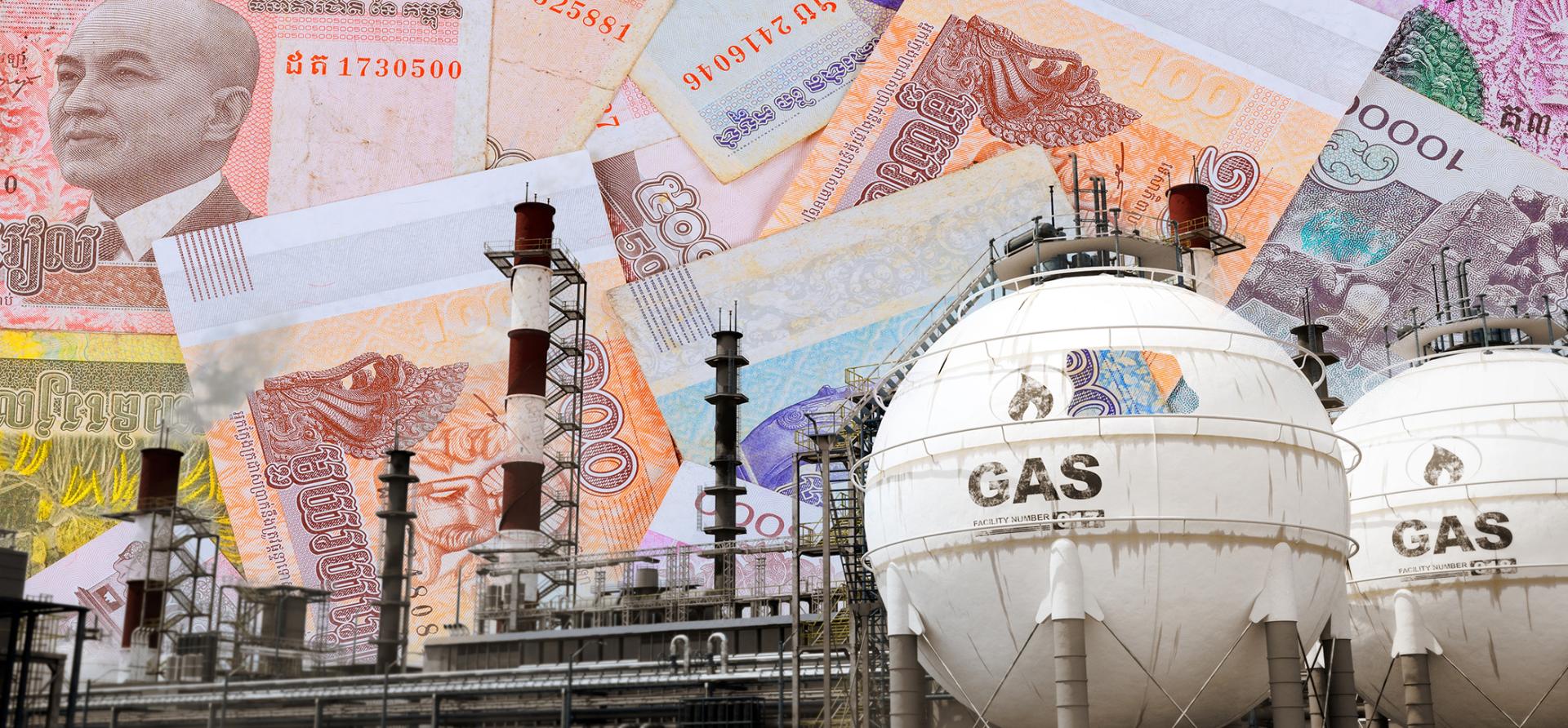Cambodia at a crossroads: An economic assessment of LNG-to-power plans
Download Full Report
View Press Release

Key Findings
In recent years, liquefied natural gas (LNG) markets have been highly unstable due to geopolitical disruptions, severe weather, supply outages, and other factors. For emerging Asian countries, an inability to secure affordable LNG supplies resulted in fuel and power shortages. Rising LNG supply will lower prices this decade, but fuel costs are unlikely to fall enough to compete with other electricity sources in Cambodia.
LNG imports will increase Cambodia’s fuel import bill and potentially hinder government efforts to reduce electricity tariffs. Recent LNG prices have been more than double imported coal prices, demonstrating the high costs of switching from coal to LNG. LNG importation has a history of increasing electricity prices in other Asian markets.
Cambodia has multiple options for buying LNG that entail various risks for energy security and cost. For example, spot markets can be highly risky during global market volatility, whereas long-term contracts can incur penalties if LNG is not needed. Developing an LNG procurement strategy will require careful consideration of these tradeoffs.
Cambodia’s small LNG demand is likely to increase the cost per unit of delivered LNG. During the earlier, limited demand stages of value chain development, the country may consider building smaller infrastructure, including small-scale import terminals or containerized LNG configurations. However, small-scale concepts could result in significantly higher per-unit LNG costs.
Executive Summary
Over the past two decades, rapid economic growth and electrification in Cambodia have driven substantial changes in the country’s electricity system. Electricity demand has grown at a blistering 16% per year since 2009, driven by high Gross Domestic Product (GDP) growth and nationwide electrification efforts. Meanwhile, the country’s power mix has evolved from a system largely dependent on fuel oil in the 2000s, hydropower in the 2010s, and, more recently, coal.
However, due to the global transition from coal and recent financial challenges for new coal plants, the country is set to begin a new phase of power sector development. Recent government plans envision significant increases in renewable energy capacity — toward a goal of generating 70% power from renewables by 2030 — as well as the introduction of liquefied natural gas (LNG) and its associated infrastructure. Although natural gas has historically not played any role in the country’s energy system, the government now expects LNG-fired power capacity to reach 900 megawatts (MW) in the 2030s, while some forecasts see it reaching 2,700MW by 2040 and 8,700MW by 2050.
The push to build large LNG-fired power plants largely stems from a concern that renewables like wind and solar do not provide uninterrupted, dispatchable power. LNG is considered a necessary transition fuel for grid reliability as electricity demand continues to rise.1 However, this report finds that the share of wind and solar generation in Cambodia has significant potential to increase without jeopardizing grid operations. Moreover, establishing an LNG supply chain will likely require rigid, long-term contracts that lock-in fossil fuel infrastructure for decades.
However, high dependence on LNG could jeopardize national energy security rather than improve it. LNG has proven unreliable for many emerging Asian nations, which often struggle to purchase the fuel when global prices spike. Even if global prices fall, LNG is highly unlikely to compete with other sources of energy in Cambodia, including solar, wind, hydropower, and coal. Cambodia is especially likely to pay above-market rates for its LNG supplies as a potential new market entrant with limited bargaining power, uncertain LNG requirements, and lower demand.
This report provides an overview of Cambodia’s power sector plans and global LNG markets, as well as key considerations for the country’s energy security and affordability as plans for LNG importation materialize.
Section 1 discusses recent trends in the country’s power sector. Section 2 examines recent global LNG market trends, focusing on the experience of emerging Asian LNG importers. Section 3 assesses the volumes and costs of various proposals for LNG imports. Section 4 examines recent cost trends in the Cambodian power sector and the potential impact of LNG-fired power generation on end-user tariffs. Section 5 provides an overview of various LNG procurement strategies and their tradeoffs. Finally, Section 6 reviews various configurations for LNG importation, including smaller-scale and containerized LNG concepts.
Key findings of this report include:
- In recent years, LNG markets have been highly unstable due to geopolitical disruptions, severe weather, outages at supply facilities, and other factors. For emerging Asian countries, an inability to secure affordable LNG supplies resulted in fuel and power shortages. Over the past two years, extreme volatility in global LNG markets has demonstrated the evident risks of LNG importation for developing economies.
- Global LNG supply is likely to increase this decade, but fuel costs are unlikely to fall to competitive levels for Cambodia’s power generation. For LNG-fired power to compete with other sources of electricity generation in Cambodia, LNG prices would likely have to fall to below US$5 per million British thermal units (MMBtu). However, prices have rarely fallen this low, as exporters typically require a selling price of US$7-8/MMBtu to recover production costs. As of August 2024, LNG prices in Asia were roughly US$14/MMBtu, and Cambodia could pay above-market rates given its small demand, uncertain LNG requirements, and inexperience with LNG procurement.
- LNG imports may involve a steep increase in Cambodia’s fuel import bill. Recent LNG prices have been more than double imported coal prices, demonstrating the high costs of switching from coal to LNG. Operating just one 900MW LNG-fired power plant could cost between US$361 million (mn) and US$722mn (KHR1.48-2.95 trillion [tn]) per year for the fuel alone.
- Relying on LNG for power generation could increase electricity tariffs, hindering government efforts to reduce rates. At current fuel prices, the cost of LNG-fired power generation could be more than five times that of recent solar projects in Cambodia. Case studies of other Asian markets show that LNG importation can cause electricity prices to increase while complicating power sector development.
- Cambodia has multiple options for buying LNG that entail various risks. Cambodia could buy LNG from spot markets, short-term contracts, or long-term contracts. Each approach faces important tradeoffs for energy security and cost. For example, spot markets can be highly risky during global market volatility, whereas long-term contracts can incur penalties if LNG is not needed. Developing an LNG procurement strategy will require careful consideration of these tradeoffs.
- Cambodia’s LNG demand is likely to remain small, which could increase the cost per unit of delivered LNG. Since LNG demand will likely remain limited in the early stages of value chain development, Cambodia may consider building smaller infrastructure, including small-scale import terminals or containerized LNG configurations. However, small-scale concepts could result in significantly higher per-unit LNG costs.
Read the Fact Sheet: Key Considerations for Cambodia’s LNG Ambitions
















